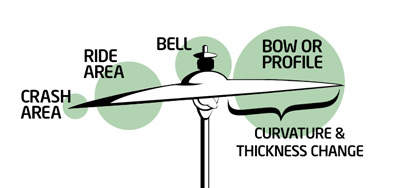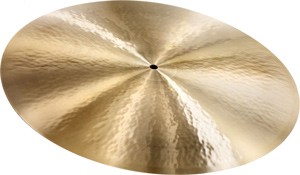The Anatomy Of a Cymbal
Written by Gunnar Egede Kristiansen – 2016
A cymbal may seem quite simple at first glance. However, cymbals are actually some of the most complax musical instruments. In this article, we take a look at the anatomy of a cymbal and we dive into what gives the cymbal its tone.

The Anatomy of a Cymbal
From an anatomical point of view, there are numerous ways to divide cymbals into groups. The design, weight, and shape are just a few of the factors that play a role in the cymbal's sound and how it feels to play the cymbal.
Therefore, this article is not a PhD thesis on cymbals but rather an introduction intended to give an overview of some of the most important aspects when explaining the tone of a cymbal.
The Cymbal's Profile
The main area used for playing the cymbal - the slightly curved area that represents the largest part of the cymbal's surface - makes most of the sound that the cymbal creates. This makes perfect sense as this is also where most of the metal is. When you view the cymbal from side profile, you see that this broad area curves in various degrees depending on the cymbal. This curve plays a major role in the cymbal's basic tone, sound, and character. A flat cymbal has a deeper basic tone with more overtones that a similar but more curved cymbal. A cymbal with a higher (more curved) profile therefore has fewer overtones and the cymbal will have a more defined attack.
The Weight of the Cymbal
According to what we now know, you must assume that a ride cymbal typically will have a higher profile than a crash cymbal (in order to have a more defined attack). However, a cymbal with a high profile also has a short resonance. But how can a ride cymbal then resonate for such a long time? This is possible because of its heavier weight. Actually, some people believe that the weight is the most important factor for how fast a cymbal's resonance dies out.
The Cymbal's Thickness
When looking at the cymbal in side profile, you see that its thickness changes. Going from the bell and down to the edge, the cymbal's thickness changes. The cymbal goes from being thicker to thinner as you get near the edge. On a crash cymbal, there is often a longer distance from the thickest to the thinnest area than on a ride cymbal.

The Cymbal's Bell
The cymbal's bell is right in the middle and has the job of making sure that the cymbals stays on the stand. However, the bell is also important for the cymbal's sound. A large bell makes the cymbal react quickly while it also gives the cymbal more overtones and more full sound. In other words, a large bell increases the cymbal's ability to crash.
A smaller bell gives a more distinct sound. The sound of a flat ride (a ride cymbal without a bell) is proof of this. This type of cymbal rarely has much volume and its sound has a lot of attack which makes the cymbal difficult to crash. If you hit a flat ride at the edge nothing really happens - the cymbal simply cannot crash.
Other Important Factors
- How you play the cymbal.
- How the cymbal is hammered.
- What the cymbal is made of (the alloy).
- How the cymbal is turned.
We take a closer look at all of this in other articles at CymbalONE.
